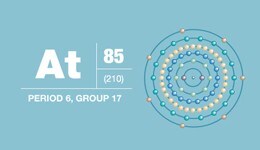Search

table of Elements
Astatine
Astatine X-ray photoelectron spectra, astatine electron configuration, and other elemental information.
Join the conversation
Astatine • Halogen
Primary XPS region: At6s
Overlapping regions: N/A
Binding energies of common chemical states:
| Chemical state | Binding energy At6s |
|---|---|
| Element | 18 eV |
Experimental information
N/A
Interpretation of XPS spectra
N/A
Symbol: At
Date of discovery: 1940
Name origin: Greek astatos
Appearance: unknown
Discoverer: D. R. Corson
Obtained from: man-made
Melting point: 575 K
Boiling point: 610 K
Density[kg/m3]: N/A
Molar volume: N/A
Protons/electrons: 85
Neutrons: 125
Shell structure: 2,8,18,32,18,7
Electron configuration: [Xe]4f145d106s26p5
Oxidation state: ±1,3,5,7 (unknown)
Crystal structure: N/A
Astatine is the heaviest of the halogens and is essentially unavailable in nature with less than one teaspoon of the element found in the Earth’s crust at any one time. In 1940, D. R. Corson, K.R. MacKenzie, and Emilio Segre of the University of California, Berkeley discovered that the only possible way of producing astatine is by bombarding bismuth with energetic alpha particles. Similar to the metallic element iodine, astatine accumulates in the thyroid gland.

Electron microscopy services for
the materials science
To ensure optimal system performance, we provide you access to a world-class network of field service experts, technical support, and certified spare parts.